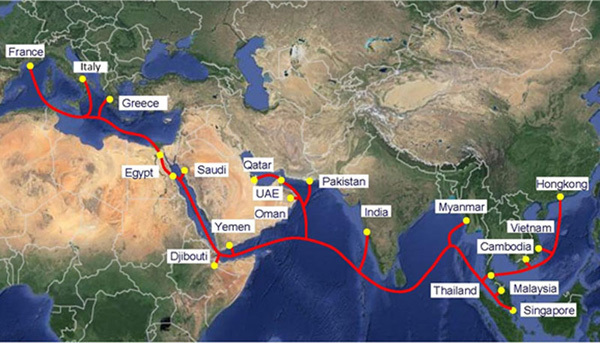Update on the progress of troubleshooting problems that occurred in recent months on international undersea fiber optic cables that Vietnam uses, a representative of an Internet service provider (ISP) in Vietnam said: Asia Africa Europe 1 cable ( AAE-1 ) is back to normal, after the fault on the S1H.4 segment is fixed.
Previously, on November 20, the cable route management unit dispatched the cable train and repaired the fault on the S1H.3 segment of the AAE-1 cable, temporarily restoring service on this route.

Diagram of AAE-1 international undersea fiber optic cable route (Photo: Internet)
In operation since July 2017, the AAE-1 undersea cable route plays the role of improving the connection quality towards Europe and the Middle East as well as providing additional capacity and redundancy towards the connection direction to Hong Kong. (China), Singapore.
The AAE-1 undersea fiber optic cable route was faulty on the same two segments on the S1H cable branch – the backbone section between Cambodia and Thailand, causing the loss of all Internet connection capacity from Vietnam to international on the route.
The fact that AAE-1 cable completely restores traffic on the route also partly relieves pressure on network operators in ensuring the quality of international Internet services for users. Because, in recent days, not only AAE-1 has had service interruptions, but also two other undersea cable routes, Asia Pacific Gateway (APG) and Asia America Gateway (AAG) have also encountered problems.
In particular, the AAG cable had a problem on the S1I branch connecting from Vietnam to Hong Kong (China) on the evening of October 22, causing a loss of all traffic from Vietnam to international on AAG cable. The system has been scheduled to be repaired, and it is expected that the repair will be completed on December 15.
As for the APG cable – put into operation at the end of 2016 and with the participation of Vietnamese carriers, on October 29, a cable error occurred on the S3 segment, causing a loss of 250G connecting Vietnam – Japan. , America on line.
In sharing with ICTnews, a representative of a network operator said that because APG encountered an error, the cable management unit decided to maintain the system. Currently, the system is being turned off the power of the HKG docking station (HongKong, China) for maintenance, combined with fixing the error that occurred on October 29. It is expected that the repair work will be completed, restoring all traffic on the APG cable on November 29.
Explaining the situation of undersea fiber optic cables that have continuously encountered problems in recent years, a representative of the Vietnam Internet Center (VNNIC) said that undersea optical cables should be subject to many objective impacts. Some of the reasons that cause sea cable lines to break or have problems include: Natural disasters (earthquake, tsunami…); Human activities such as fishing boats, anchors, submarines, especially in areas with bustling maritime activities; Sea creatures attack the cable… In addition, the equipment can self-destruct, but this is very rare because businesses are regularly monitored and maintained.
“Fiber cable breaks are a common situation, averaging hundreds of incidents each year globally. However, we rarely hear about this because most carriers have plans to ensure omnidirectional connectivity on many cables to reduce the risk of losing connection in one direction,” said VNNIC representative. more information.
Discussing the impact of undersea cable incidents on Internet access speed from Vietnam to international destinations, experts said that Vietnamese enterprises are participating in exploiting a number of international undersea fiber optic cable routes: AAG, SMW3 (also known as SEA – ME – WE3), Pan Asia (IA – Intra Asia), APG and AAE-1. The bandwidth of international Internet connection in Vietnam is mostly through these undersea fiber optic cables, so the failure of 1-2 cable lines will directly affect the international Internet access speed of Vietnamese Internet users. Male.
To minimize the impact of undersea cable incidents to service users, every time there is a problem with a cable route, ISPs deploy a plan to increase the traffic of other routes, regulate and prioritize traffic to ensure service. be transparent, in accordance with the commitment to provide services to customers.
Simultaneously, ISPs also conduct emergency response connections to priority service providers; plan to connect to strengthen and expand sea cable or expand connection channels on land, satellite … in many different directions.
.
